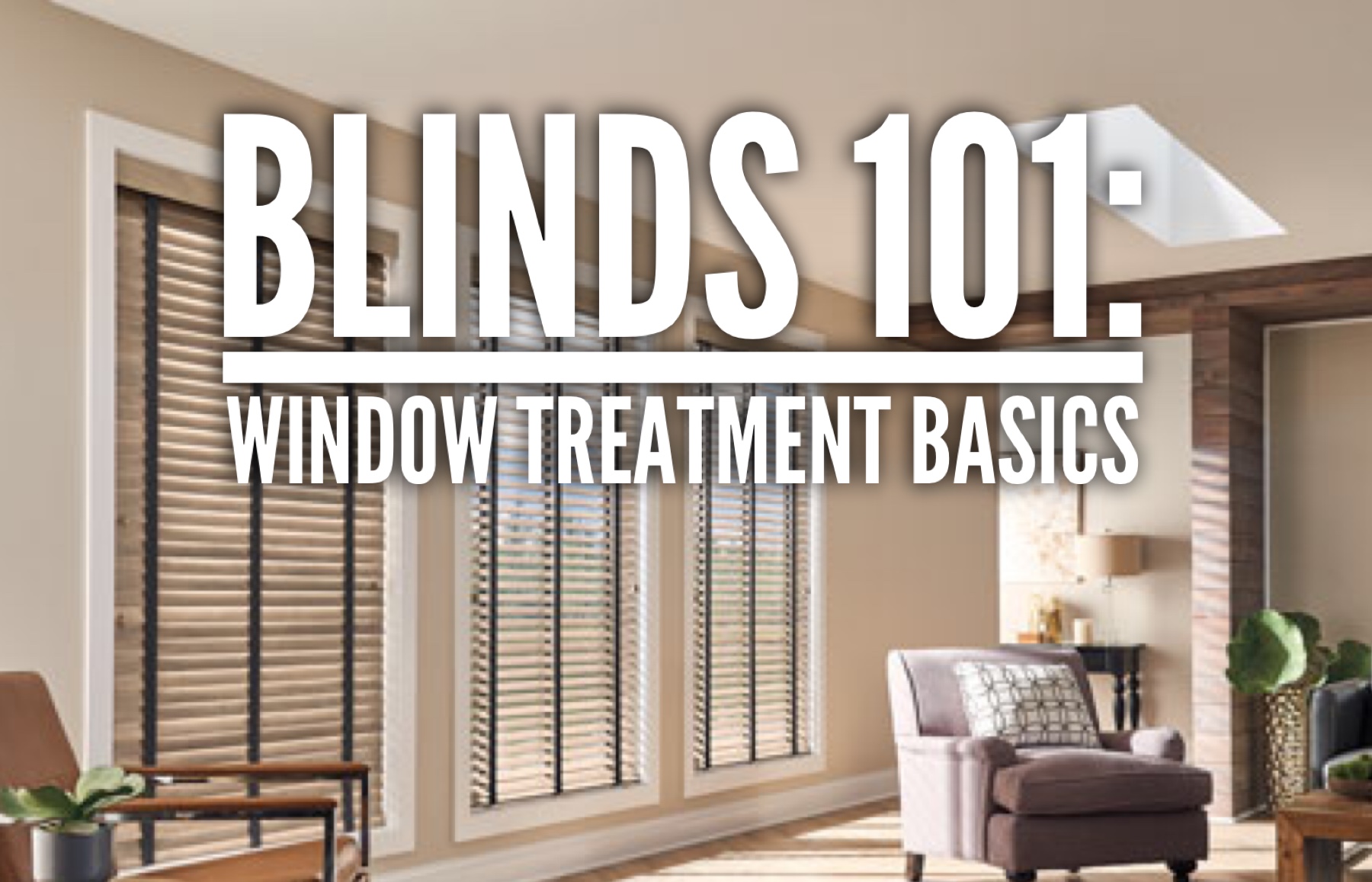Offering a beautiful, clean and classic look, blinds are a popular and cost-effective window treatment. With so many options, however, choosing the right blinds for your home can be challenging. Below, we’ve provided some “blind basics” to help get you started.
Introduction to Blinds
Blinds are often called “hard” window treatment because they are typically comprised of slats made from solid materials, such as wood, composites and metals. In contrast, shades and curtains are often called “soft” window treatments because they are typically made from softer weaved fabrics. With blinds, the slats may run horizontal or vertical.
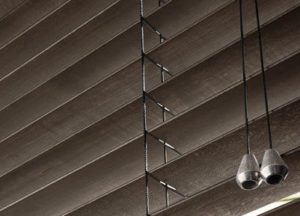 Horizontal blinds, which are sometimes called Venetian Blinds, are mounted either (1) recessed inside the window frame or (2) outside and above the window. How blinds are installed is dependent upon multiple factors including the depth of your window frame, how your window opens, and style preference.
Horizontal blinds, which are sometimes called Venetian Blinds, are mounted either (1) recessed inside the window frame or (2) outside and above the window. How blinds are installed is dependent upon multiple factors including the depth of your window frame, how your window opens, and style preference.
The slats are connected by a network of cords called a ladder. The ladders run vertically through the slats and are necessary for raising, lowering and tilting the window covering.
Blinds are easily adjustable and effective at controlling light and privacy. Slats rotate back and forth by 180 degrees by either pulling a short cord or rotating a wand. Blinds can be fine-tuned for optimal light and privacy control or closed tightly. When raised and stacked at the top of the window, they offer an unobstructed view.
Vertical blinds are a great choice for covering wide window expanses or sliding glass doors. With vertical blinds, the slats are perpendicular to the ground, travel along a track at the top and stack to the side of the window or door. Available in many different materials ranging from wood to composites or vinyl to sheers, vertical blinds are typically considered a more contemporary window covering style.

Blinds are easily cleaned. Since blinds are made from hard materials, they can be dusted with a soft cloth or cleaned with furniture polish. For those of us with pets and kids, blinds are a more durable choice when cared for properly.
Purchase Considerations
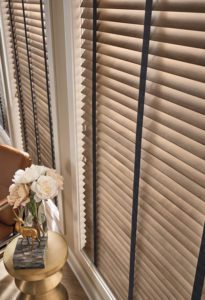 When purchasing blinds for your home, some considerations include (1) material, (2) slat width, (3) routing holes, (4) decorative options, and (5) safety.
When purchasing blinds for your home, some considerations include (1) material, (2) slat width, (3) routing holes, (4) decorative options, and (5) safety.
Materials:
Custom blinds are available in a variety of materials including natural wood, composites, faux wood and aluminum. When choosing a blind material, you need to consider function as well as style.
In my opinion, there is nothing like the rich beauty and natural grain of wood blinds. Perfectly suited for traditional, contemporary or modern homes, wood blinds come in a variety of paint finishes and lush looking stains. It’s like fine-furniture for your windows.
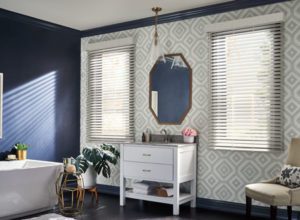 If you’re looking for a more economical option, consider faux wood or composite materials. While construction varies by manufacturer, faux wood slats are often constructed with a wood core coated in a vinyl or PVC material. It is moisture resistant and ideal for humid rooms like bathrooms and laundry rooms. Most manufacturers offer faux wood in the same colors and finishes as natural wood blinds, which allows you to coordinate your look throughout your home while choosing the best material for the environment.
If you’re looking for a more economical option, consider faux wood or composite materials. While construction varies by manufacturer, faux wood slats are often constructed with a wood core coated in a vinyl or PVC material. It is moisture resistant and ideal for humid rooms like bathrooms and laundry rooms. Most manufacturers offer faux wood in the same colors and finishes as natural wood blinds, which allows you to coordinate your look throughout your home while choosing the best material for the environment.
While many people use the terms faux wood and composite blinds interchangeable, they are not the same. Composite blind slats are typically made from a materials comprised of wood pulp and plastic resins. They’re resilient, durable, and lighter in weight than faux wood.
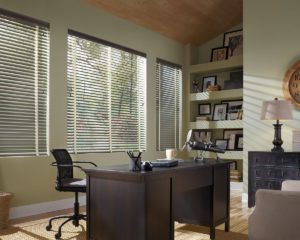 Aluminum blinds offer a more contemporary look and are less expensive, which makes them a perfect option for rental and commercial properties. Durable and easily maintained, some aluminum blinds offer anti-static finishes that repels dust and resists scratches and stains. Purchasing aluminum blinds from a custom window treatments company, like Made in the Shade Wichita, will typically get you a thicker slat and better components.
Aluminum blinds offer a more contemporary look and are less expensive, which makes them a perfect option for rental and commercial properties. Durable and easily maintained, some aluminum blinds offer anti-static finishes that repels dust and resists scratches and stains. Purchasing aluminum blinds from a custom window treatments company, like Made in the Shade Wichita, will typically get you a thicker slat and better components.
In addition to preference and moisture considerations, lighter materials like natural wood require fewer ladders. Heavier materials like faux wood require more ladders. This means real wood slats have less cords hanging down supporting the slats.

Slat Width:
Most blinds are available in a variety of different slat widths ranging from 1-inch to 2.5 inches. The most popular width for wood, composite and faux wood blinds is 2-inch slats. While slat width is primarily a preference, we do recommend coordinating the slat width with the size and scale of your windows as well as keeping slat width consistent throughout your home.
Functionally, the larger the slat width the more room between slats and the less slats obstructing the view. This means a 1-inch slat will have 1-inch between slats; 2-inch slats have 2 inches between slats; and so on.
Decorative Options:
Decorative options like custom colors, holes, decorative fabric tapes and valences can help your room make a statement. While most manufacturers of custom blinds offer a wide variety of paints and stain options, you can also choose custom colors to match your room’s furnishings, artwork and accent colors.
 The cord ladders on most blind slats are threaded through holes, which are typically called route holes. This helps secure the slat to the blind for the purpose of raising, lowering and tilting the slats. With routless blinds, which are blinds without holes, the cord ladder runs along the outside of the blind slat. Not having holes provides more light control and additional privacy. It also means the slats aren’t as secure and may not stay in place. For this reason, we typically don’t recommend routless blinds for customers with children or pets, or installed on doors.
The cord ladders on most blind slats are threaded through holes, which are typically called route holes. This helps secure the slat to the blind for the purpose of raising, lowering and tilting the slats. With routless blinds, which are blinds without holes, the cord ladder runs along the outside of the blind slat. Not having holes provides more light control and additional privacy. It also means the slats aren’t as secure and may not stay in place. For this reason, we typically don’t recommend routless blinds for customers with children or pets, or installed on doors.
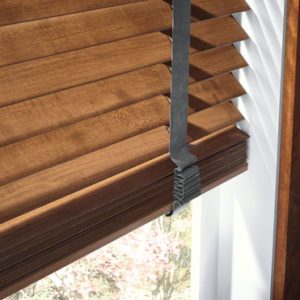 Decorative fabric tapes are installed vertically on blinds and cover the ladders. This decorative feature makes blinds look truly custom and adds to light control by obstructing the route holes, which may let light through. Decorative fabric tape is ideal for matching to other window treatments, such as draperies, or even throw pillows.
Decorative fabric tapes are installed vertically on blinds and cover the ladders. This decorative feature makes blinds look truly custom and adds to light control by obstructing the route holes, which may let light through. Decorative fabric tape is ideal for matching to other window treatments, such as draperies, or even throw pillows.
While most blinds come with a decorative fascia standard you can order custom top treatments, such as valences or cornices, to create a uniquely stylish and custom look. A fascia is simply a flat or semi-decorative piece of material used to cover the blind components at the top of the window.
 Valences and cornices, while the terms are often used interchangeably, are different types of top treatments. Valences are basically soft top treatments that hang freely at the top of a window. Often installed with on a curtain rod or mounted on a board, valences are typically made from fabric and have a soft, flowing appearance. A cornice is more ridged than a valence and may be constructed from harder materials, such as wood, or a board upholstered with fabric. Both valences and cornices may be paired with blinds.
Valences and cornices, while the terms are often used interchangeably, are different types of top treatments. Valences are basically soft top treatments that hang freely at the top of a window. Often installed with on a curtain rod or mounted on a board, valences are typically made from fabric and have a soft, flowing appearance. A cornice is more ridged than a valence and may be constructed from harder materials, such as wood, or a board upholstered with fabric. Both valences and cornices may be paired with blinds.
Safety:
One often unforeseen danger to young children is window covering cords. In fact, the United States Consumer Product Safety Commission considers corded window coverings one of the top five hidden hazards in American homes.
Today, almost every window treatment is available with safety features. Blind manufacturers, such as Graber, Alta and Norman, are certified “Best for Kids” meaning their products meet safety criteria and were submitted to an independent third party testing laboratory. In addition to cordless lift, these manufacturers offer blinds with short tassel pull cords or wands for tilting and continuous-loop cords that are permanently anchored to the floor or wall.
For questions, or if you are considering new blinds for your home or business, call Made in the Shade Wichita at (316) 272-2173 to schedule a free, in-home consultation.

